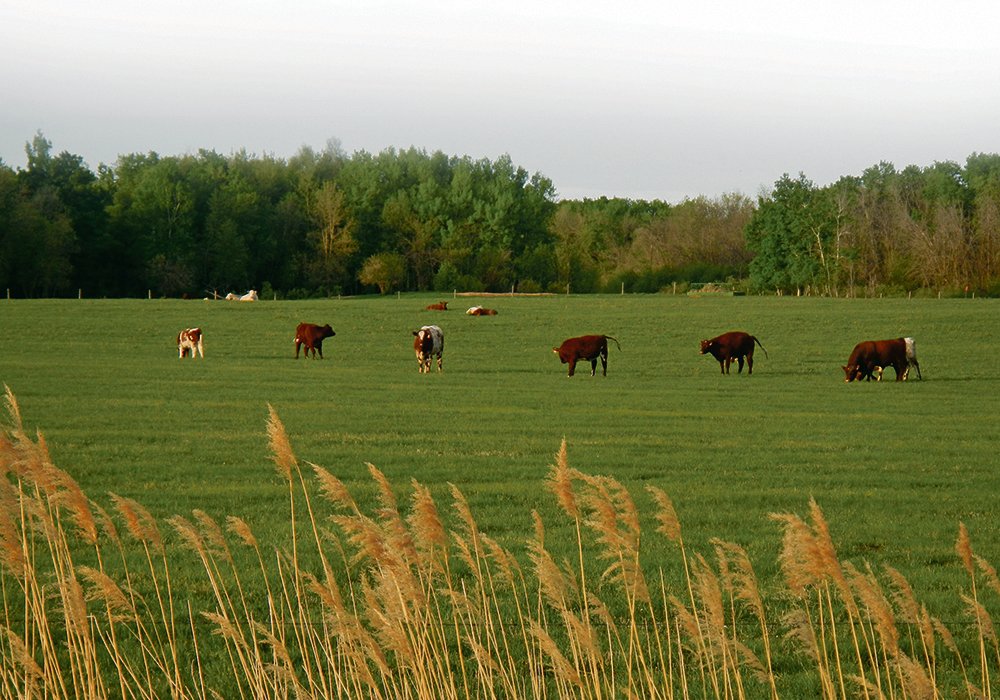Water shortage worsens for Manitoba cattle producers

Recently, Tyler Fulton and his parents looked at the historical records for their family farm near Birtle, Man.
The records showed that the spring of 2021 is exceptional, but not exceptional in a good way.
“We’ve got surface water conditions that are the lowest that I (can) recall,” said Fulton, president of Manitoba Beef Producers.
“If the current moisture situation… is not unprecedented, we’d have to go back 40 years to find something similar.”
Fulton’s ranch is in the prairie pothole region, a rolling landscape with ravines, depressions and sloughs. But in early June there was little water in the creeks that flow through Fulton’s farm, the sloughs were drying up and some dugouts were empty.
On June 3, he took a photo of a dugout that was basically a puddle of water, barely enough for a duck to get wet.
In a normal year, that dugout could supply water for cattle until August.
Fulton’s dugout and hundreds of other dugouts across southern Manitoba and Saskatchewan are half full or nearly empty right now because of minimal snowfall this winter and little or no rainfall last fall.
“We never had any spring runoff this year,” he said, adding most of the snowmelt went into the soil.
Fulton and most cattle producers in the province are concerned about the shortage of water and poor pasture growth this spring.
On June 7, Manitoba Beef Producers had a telephone call with Manitoba agriculture minister Blaine Pedersen to discuss the situation and potential solutions.
Many ranchers will need assistance this spring and summer so they can drill new wells, buy pumps and get help with hauling water.
“A few producers had to pump water to fill their reservoirs for irrigation or for livestock. With dugouts lower than normal to start the grazing season, there is concern how long the water will last,” said the Manitoba Agriculture crop report in early June.
On Fulton’s ranch, hauling water isn’t a realistic option. He has 600 cow-calf pairs on pasture and it would be difficult to transport enough water for a herd that size. On warm day, a pair would likely drink 30 gallons of water per day, Fulton said.
“Across 600 pairs you’re looking at 18,000 gallons (per day). That’s beyond any capacity we currently have,” he said, noting that would be three semi-tankers of water per day.
“It would be a full-time job.”
A better solution for Fulton is pumping water. He has three dams on a ravine and there’s water in those reservoirs. But pasture land is four to five kilometres away.
“We’ve got a supply but we need to get that (water) to the place where the grass is,” he said. “We need support to be able to pump the water, to where it needs to be.”
A number of producers have already cut back their herds because they won’t have sufficient water supplies this summer.
In early June, Fulton took a truckload of cattle to an auction mart in Virden. Other producers were doing the same thing.
“It was obvious that (the numbers) were well beyond what is typical, for what is seasonal for this time of year,” he said. “There’s a lot of animals going to market.”
Lack of water supply is top of mind for thousands of cattle producers this spring, but poor pasture growth is also a major issue.
Pam Iwanchysko, livestock specialist with Manitoba Agriculture in Dauphin, is worried about pastures and forage crops in the region.
“Pastures would be my No. 1 concern (compared to hayland). If we don’t get additional moisture they’re not going to hold out for very long,” she said. “There’s limited growth on (pastures) right now…. How long will those cows be able to be out there, is the big question.”
Many pastures that were continually grazed in 2020 are not in good shape. They haven’t had the necessary time to recover.
“When you allow rest and recovery, the plants grow back much quicker. The yield is higher,” Iwanchysko said. “I can’t stress than enough.”
We have trouble…along with thousands of farmers and ranchers in Manitoba, we are running out of water for livestock due to drought. Yesterday, we were forced to pull 200 pairs off a 200ac pasture due to lack of water. In past dry years this dugout provided water until August. pic.twitter.com/YMF3kyKMxy
— E Tyler Fulton (@ETFulton) June 5, 2021
Deficient growth on pastures is troubling, but cattle producers are a resilient and resourceful bunch, Fulton said.
In a drought year like 2021, some ranchers will seed oats, millet or sorghum, so they have an alternate source of feed. Plus, some forage species can recover if there are decent rains in June.
But spring rains don’t refill sloughs and dugouts.
“Even if we get an inch or two inches, it’s not going to address the livestock water issue, which is preventing us from using much of the pasture that we have,” Fulton said.
In May, Manitoba Agriculture said it will list parcels of crown land located in wildlife management areas, which could be used for temporary grazing.
The province also offers funding for beneficial management practices (BMPs) that improve livestock access to water. It includes things like drilling new wells, expanding dugouts and installing water pumps and pipelines.
The province should open up the program to new applications so farmers can find solutions to this year’s water shortage, Fulton said.
“There is a diversity of (solutions)… and I think really everything should be on the table.”
On June 7, the province made more crown land available for cutting hay. For more information on locations and the allocation process, visit www.manitoba.ca/agriculture/land-management/crown-land/.
Source: producer.com

